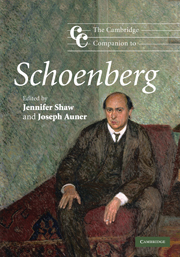Book contents
- Frontmatter
- 1 Introduction
- Part I Schoenberg's early years
- Part II Schoenberg, modernism, and modernity
- Part III Schoenberg between the World Wars
- 10 Schoenberg as teacher
- 11 Schoenberg, satire, and the Zeitoper
- 12 Schoenberg's row tables: temporality and the idea
- 13 Immanence and transcendence in Moses und Aron
- 14 Schoenberg, the Viennese-Jewish experience and its aftermath
- Part IV Schoenberg's American years
- Notes
- Select bibliography
- Index
12 - Schoenberg's row tables: temporality and the idea
from Part III - Schoenberg between the World Wars
Published online by Cambridge University Press: 28 September 2011
- Frontmatter
- 1 Introduction
- Part I Schoenberg's early years
- Part II Schoenberg, modernism, and modernity
- Part III Schoenberg between the World Wars
- 10 Schoenberg as teacher
- 11 Schoenberg, satire, and the Zeitoper
- 12 Schoenberg's row tables: temporality and the idea
- 13 Immanence and transcendence in Moses und Aron
- 14 Schoenberg, the Viennese-Jewish experience and its aftermath
- Part IV Schoenberg's American years
- Notes
- Select bibliography
- Index
Summary
Schoenberg's interest in chords and melodies using all twelve tones emerged as early as 1910 during the composition of his opera Die glückliche Hand, Op. 18 (1910–13) and as he was writing the final chapters of his Theory of Harmony (1910–11). The sketches for his unfinished choral symphony, which he started in 1914, include a twelve-tone row and its transformations. During the years of World War I, and then more systematically in 1920–23, he experimented with ordered and unordered collections of various lengths, using a technique he described as “working with tones of the motif,” in works and fragments including Die Jakobsleiter, the Five Pieces for Piano, Op. 23, and the Serenade, Op. 24. The Suite for Piano, Op. 25 (completed in 1923 and published in 1925) is the first piece to use twelve-tone techniques throughout, while the Wind Quintet, Op. 26 (1924) was the first to use a single row for all the movements. And though he never stopped writing tonal music, the project of exploring the manifold ramifications and possibilities of the “method of composing with twelve tones related only to one another” remained at the center of his creative life for the next twenty-seven years.
In contrast to his extensive writings on tonal theory, however, Schoenberg wrote very little concerning the details of twelve-tone composition. The essay “Composition with Twelve Tones,” published a year before his death in the first edition of Style and Idea (1950), was his most substantial public statement. As a result, we primarily owe our understanding of Schoenberg’s twelve-tone method to the work of three generations of composers, historians, and theorists who have produced an extraordinary body of scholarship and new compositions formalizing and extending Schoenberg’s ideas. These developments have necessarily brought with them considerable standardization in the pedagogy of twelve-tone theory and analysis. While some differences still persist, the adoption of a shared terminology, conceptual framework, and conventions of representation, have led to an ease of communication between scholars and composers and thus to the flourishing of what has become an important discipline in the field.
- Type
- Chapter
- Information
- The Cambridge Companion to Schoenberg , pp. 157 - 176Publisher: Cambridge University PressPrint publication year: 2010
- 3
- Cited by



